If you meet someone named “Boom Boom Betty” or “Sally Slammer,” chances are they play roller derby. What? You’ve never heard of roller derby? Then it’s time you pulled yourself up to the jammer line so we can begin our journey into this fun, fast and furious sport.

This article will look at what roller derby is, its evolution, the rules, and some fun facts about the sport. While some may think it’s merely a race on wheels with a lot of crashing, smashing, and trash-talking, roller derby is so much more.
As Old as Rollerskating Itself!
With the birth of any new invention, someone finds a way to make it more fun and exciting. In 1863, James Leonard Plimpton invented and patented the very first roller skates. It wasn’t long after that, in the 1930s in Chicago, Leo Seltzer, a sports promoter, was credited as being the inventor of the first roller derby tournament.
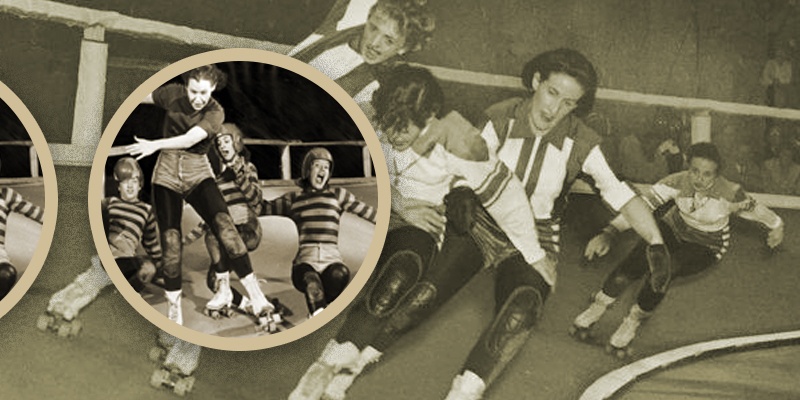
The first Transcontinental Roller Derby happened on August 13, 1935. Twenty thousand Chicagoans piled into Chicago Coliseum to witness 25 teams skate 3,000 miles around the track. The distance they would skate would equal the distance between San Diego and New York City.
Leo noticed all of the wacky sports-related contests happening in the 1920s and thought there might be room for one more crazy contest collaboration. After reading an article that over 90% of U.S. residents had roller-skated at least once in their life, he figured it only made sense to take advantage of a popular sport and make it more exciting.
Bumps and Bruises: The Birth of Body Contact Roller Derby
Seltzer’s first roller derby was less elbow to the face and more of a frantic race to the finish line. Although roller derby would become a female sport predominantly, it was also one of the sports where men and women teammates competed together.
They would take turns continuously skating laps to be the first to collect a cash prize. The tracks were wooden, and the racers had their fair share of spills and falls. Spectators watching from the sidelines enjoyed this action just as much as the outcome!
As the popularity of roller derby caught on, sportswriter Damon Runyon noticed that the more tumbles that happened during the race, the more the fans loved it. So he approached Seltzer and suggested focusing on the rough aspects of the sport to bring in the crowds.
Redefining the Sport of Roller Derby
Within no time, roller derby was becoming an organized and structured game with an established point system, and some roller derby rules were enforced. You earn a point if you pass a person, and roughing up the opposing skaters was encouraged.
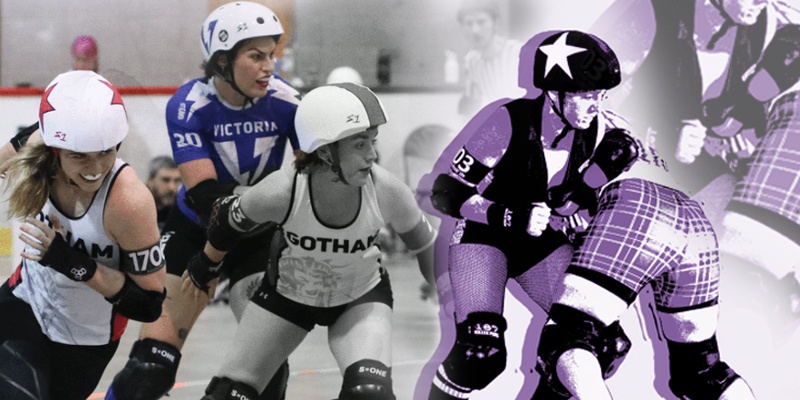
Skaters would start to use physical force and put other skaters into headlocks, give them an elbow to the chin, lock hands and spin around, all while going at very high speeds. It wouldn’t take much before the aggression escalated, and full-on fistfights ensued.
Referees had to be introduced to break up the scuffles. The extra hits were a hit, and the version of the full-contact sport we know today was born. The crowds loved it!
A Theatrical Spectacle!
With the addition of teams using physical force against one another, it only made sense to add a bit of drama. Flat track roller derby became as choreographed as pro-wrestling. Each new roller derby team playing a home team was promoted as a rivalry for fans with villains and heroes.
Roller Derby teammates were billed as either good or bad, and they riled up the crowd with hit after hit. When roller derby made it onto television in the 1950s and 1960s, the game’s popularity was a force to be reckoned with.
Fans would pack Madison Square Gardens in New York City to slam their senses with the action and speed of the sport. Some may have found it hard to follow the game’s rules, but it didn’t matter; as Seltzer said, the sport has all of the fundamental appeals “noise, color, body contact.” Professional roller derby was just around the bend.
Modern Roller Derby
Roller Derby may have started in the United States, but its popularity spread worldwide, with many countries beginning leagues of their own. The sport has seen several resurgences over the century.
RollerGames debuted on national T.V. in 1989 and gave a new theatrical twist to the sport. It had fans glued to the T.V. The game was based on a figure-8 track with a new set of rules for the track design. Sadly, it ran for one season because a few of its syndicators went bankrupt.
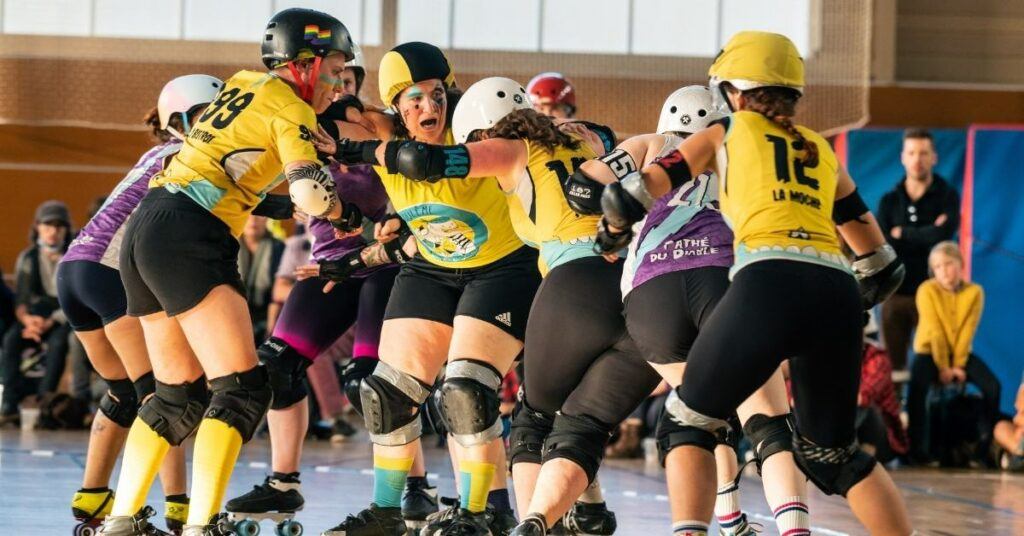
Roller Derby teammates even had special derby names like “Mazel Tov Cocktail,” “Princess Lay-Ya Flat,” and “Anna Mosity,” and event names also had a play on words like “Night of the Rolling Dead.” If you wanted to play roller derby, you would even have to check an international roster to ensure you don’t use another player’s derby name.
In 1999, TNN launched the popular RollerJam. This version of the sport brought back the classic rules and banked oval track. The only difference is that it allowed inline skates along with the traditional quad skates. Jerry Seltzer was still active with the sport he created by being a commissioner for this version.
Rolling Into The 21st Century
Roller derby once again revived in the early 2000s in Austin, Texas, as an all-female, woman-organized amateur sport. By the mid-2000s, the sport had developed over 135 leagues in the U.S. alone. Many more leagues started outside of the country.
By 2009, the Women’s Flat Track Derby Association (WFTDA) was born. This association is the international governing body for roller derby. It includes over 2,000 amateur leagues from countries like Canada, Australia, France, the United Kingdom, Germany, Belgium, Israel, China, Finland, and more.
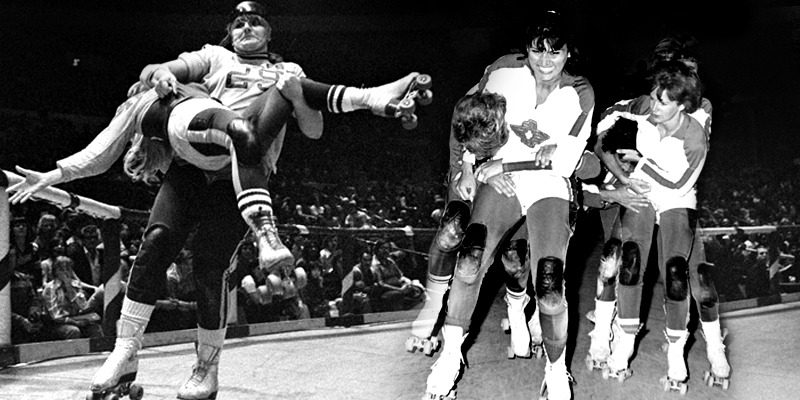
In 2009, fans were still in love with roller derby. A feature film, “Whip It,” starring Ellen Paige and Drew Barrymore, made it onto the big screen and kept the fanbase alive. The film’s success made it possible for companies to use roller derby to sell everything from insurance, breakfasts, and even over-the-counter analgesics.
Roller Derby Today
It is still predominantly women who play the sport, but roller derby is such a popular team sport that men and even children play. However, the sport shows how quickly pop culture and social media promote a fun sport while also highlighting how women’s role in society is constantly changing.
Today, many leagues are self-organized, amateur, led and organized by women, and focus on teamwork, friendship, feminism, and a do-it-yourself attitude regardless of the team affiliation. The aesthetics have changed from looking like a sport to having a punk look and feel to the game.

Today, most competitions happen on flat tracks. However, several leagues still skate on banked tracks, and many more concepts are being planned for future tracks. While most leagues travel to nearby cities to play local roller derby games, some teams play nationally and even internationally. Although it was rejected, in February 2012, roller derby was on the table as a consideration by the International Olympic Committee to be part of the 2020 Olympic Games.
Today the sport is enjoyed by all genders and ages. In May of 2013, 140 junior roller derby programs were happening across the United States and in other parts of the world. Roller derby events popped up everywhere, donning unique names and themes, and the WFTDA live streams its tournaments on wftda.tv.
The way people play roller derby and watch the sport may have changed a bit from its early days, but the thrill and excitement are still alive and rolling. Now that we know roller derby will be around for a long time let’s break down the various aspects of the game.
How to Play The Game
Watching a roller derby game may seem confusing, and you may wonder how roller derby is played. There are set rules and point systems in place, and there are positions to be played, penalties, and referees to keep the fights to a minimum and keep the game going.
Since those early days, the sport has changed quite a bit, and with its evolution, rules, points, and more have been added. Let’s break down everything you need to know about roller derby.
The Object of the Game
The object of a roller derby game is similar to almost every other sport – to score points. Two teams are each trying to score the most points in a game. Scoring points in roller derby happens only during periods known as jams, and to score a point, each team’s jammer or lead offensive player has to lap an opposing team member. Each time they do so, a point is awarded.
Since it is a full-contact sport, the defensive players or the team’s blockers use physical force to stop the opposing team’s jammer from passing. They can also clear a path for their own jammer to lap as many opposing skaters as they can to score points. Whoever has the most points wins.
Most roller derby games are played on a flat track layout, while a few are played on banked tracks. A banked track has a different design meant to keep the momentum going, but most banked track versions are expensive and offer more dangerous spills.
Since most leagues are amateur, they use the flat track design to save money and keep things simpler and safer. Most leagues play under a governing body called the Women’s Flat Track Derby Association (WFTDA) and use their rules and regulations.
However, playing the game involves strategy and endurance. Let’s explore the game’s rules and how it’s played.
Game Play
Roller Derby teams can be made of up to 14 players. However, only five team members from each team can be on the track at any given time. The team members are made up of the following:
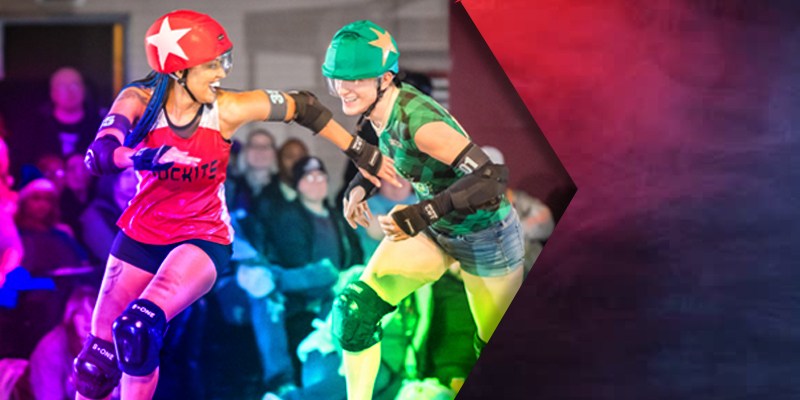
Jammer
Each team has one jammer, and they’re usually the fastest player on the team. They are the only team member who can score points. A jammer wears a helmet cover with a star on both sides so other players can identify her on the track.
Blockers
The remaining skaters are made up of four blockers, and the main objective of those four skaters is to stop the opposing jammer from lapping them and scoring. One blocker is known as the pivot blocker, and they are also the team captain who calls the shots for their team to play and keeps the pack’s pace. The pivot blocker wears a helmet cover with a stripe on it.
When the Whistle Blows
Roller derby matches are played on an oval-shaped track and played in two periods of 30 minutes each. The track is designed flat and clean with correct dimensions and boundaries marked clearly. This helps the skaters stay within the bounds of the track. Skaters should be able to spot the pivot and jammer lines to keep track of when laps begin and end.
The four blockers from each team position themselves between two lines marked on the tracks – the pivot line and the jammer line and form what is called “a pack.” Meanwhile, the two jammers line up behind the jammer line.
The game begins with blockers from each opposing team skating as a single pack around the track. Once this pack passes the starting line and the last blocker is 30 feet from the line, the referee blows the whistle, and each team’s jammer begins to skate. At this moment, all opposing team members can engage one another.
The jammer scores no points during the first lap, but once the first jammer passes each blocker and opposing jammer, they are now considered the lead jammer. The jammer referee will point out the lead jammer and make an “L” with their hand, indicating the lead jammer status to that player.
A lead jammer can end a jam before the two minutes are up by repeatedly gesturing her hands to her hips. If both jammers commit fouls, the jam goes the full two minutes. A jammer can pass off her helmet cover to the pivot. By doing so, the pivot now becomes the lead jammer.
The jammers have to take every opportunity to skate as fast as they can or try and fight their way through the pack to pass an opposing blocker or jammer in a lap and score a point. Each time a jammer scores, the jammer referee holds up their fingers to indicate a point.
Penalties
A game of roller derby has four officiating referees skating inside the track. They are made up of a head referee, a pack referee, two jammer referees, and non-skating officials (NSOs). The referees are an essential part of the game, making sure things roll along smoothly.
#1. Jammer Referee
Since there are two jammers, there are two jammer referees. They award points each time their respective jammer scores.
#2. Pack Referee
The pack referee watches the rest of the team members. They watch the pack of blockers, make sure there is no unnecessary roughness happening, and call penalties on blockers when necessary.
#3. Head Referee
The head referee’s job is to supervise everything that is happening. They will give the final ruling on any expulsions during the game and have the last say for all things related to the gameplay and points.
#4. NSOs
The job of NSOs is also important. They time the jams, record and display the scores, and display and record the penalties called out by the referees. They also keep count of how many players are on the track at one time.
NSOs can issue penalties for a variety of reasons. These can include:
- Tripping
- Blocking a player above the shoulder
- Blocking a player when out of bounds
- Blocking a player with the arm below the elbow
- Charging from the rear
Even though roller derby is a full-body contact sport, players cannot use their heads, elbows, hands, forearms, or legs to block an opposing team player. Blockers must only use their hips and hit only the opposing team player’s hips. A hit that occurs anywhere else on the body will land them with a penalty.
Penalized skaters have to spend 30 seconds in the penalty box. However, they can serve the last 10 seconds standing in the penalty box, so they’re ready to make it back onto the track. Jammers will lose lead jammer status if sent to the penalty box during the jam.
Another way a player can end up in the penalty box is by using inappropriate language. Some referees turn their ears the other way and allow some accidental swearing – this happens mostly in amateur leagues. However, swearing at another player or a referee will almost always result in a penalty.
Another way to get a penalty would be to interfere with the flow of the game in any way. For example, if your own jammer or the opposition jammer leaves the track mid-game and disrupts the game flow. It’s only acceptable when an opposition jammer or opposing blockers leave the track to retrieve out-of-bounds helmet covers.
Winning the Game
Like with many other sports, the team with the most points at the end of the match is the winner. Games are not allowed to end in a tie, so an overtime jam is set to determine a winner. In these overtime jams, there is no lead jammer.
Instead, the team with the most points at the end of the overtime jam is deemed the winner. If the overtime also has a tie, the game is continued with many more overtime jams until one team wins.
Rough and Tough Roller Derby
Roller derby is a full-contact sport. This means that there are bound to be some injuries. Most of the injuries are simply bruises, which the players proudly show how tough they are. However, broken bones, knocked-out teeth, and concussions also occur – even with the safer flat-track roller derby.
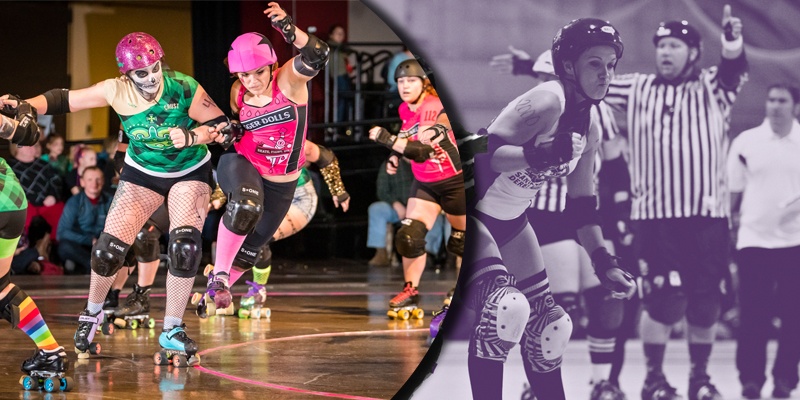
For the most part, roller derby is relatively safe if the players pay attention. There are rules in place that a medical professional must be present at all games to deal with injuries, and the WFTDA has insurance packages for leagues in the United States that cover accidents and liabilities. However, most leagues recommend that players take out their own insurance coverage.
Roller Derby Equipment
USA Roller Sports requires that all league players use quad roller skates instead of inline skates. This is because quad roller skates are designed with a smaller wheelbase. Since inline skates have a longer wheelbase, they can cause unnecessary tripping hazards for the players. Quad roller skates are not as easy to control as inlines, making the game harder to play.
Other equipment league players are required to wear are:
- Mouth guards
- Knee pads
- Elbow pads
- Wrist guards
- Helmet
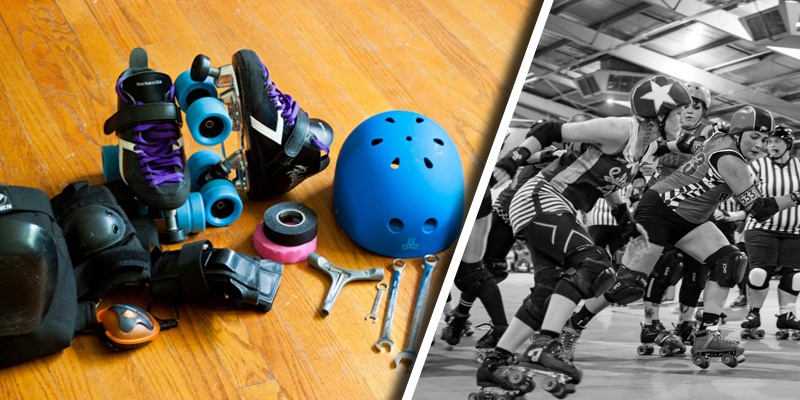
Other than wrist guards and elbow pads, people can wear some gender-specific protective gear. Women can wear protective sports bras, and men can wear protective cups. In addition to team derby skates, teams usually wear a team uniform shirt, have knee-high socks, and print their derby names on their uniforms.
The game can get pretty rough for adult leagues, but for younger roller derby enthusiasts, certain practices were put into place. The Junior Roller Derby Association (JRDA) ensures that young skaters must follow safety rules and learn roller skating techniques on quad skates to help prevent injuries.
Tournaments and Organizations
Since 2006, WFTDA has sponsored an annual championship, and in 2008 it created four regional playoffs with a final championship tournament. As of 2019, the WFTDA postseason consists of two playoffs that lead to a final championship tournament. There are also three separate regionally-based Continental Cups. The WFTDA also allows and recognizes suitable matches and tournaments that are hosted by member leagues.
The first Roller Derby World Cup was held in Toronto, Canada, in December of 2011, and the second World Cup was held in Dallas, Texas, in December 2014. Since 2010, “The Great Southern Slam” has been held biannually in Adelaide, South Australia. It was hailed as the largest roller derby tournament in the southern hemisphere.
The End of Our Jam
Taking roller skating and turning it into roller derby paved the way for female athletes to participate in a sport predominantly their own. With the players’ strength, endurance, and skill and a large following of spectators, roller derby skyrocketed to secure its place among sports lovers worldwide.
Although the sport has gone through a few facelifts over the last century, the basics remain, with one team rising victorious over the other. Like the players, the roller derby game has taken its fair share of bumps and bruises throughout the decades. And just like the players, roller derby keeps getting back up and giving us lap after lap of endless excitement!
